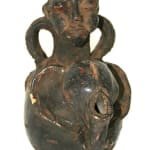Grasslands Terracotta Vessel in the Form of an Elephant and Rider, 20th Century CE
Terracotta
MT.301 (LSO)
Further images
This is a gourd-shaped vessel with an extremely unorthodox upper half, and a spout in the form of an elephant and rider. It sits upon a small pedestal base with...
This is a gourd-shaped vessel with an extremely unorthodox upper half, and a spout in the form of an elephant and rider. It sits upon a small pedestal base with incised decoration. The vessel itself is plain, merging seamlessly into the elephant’s head and the rider’s body. The rider sits with curved back and loop arms that serve as handles; the face is fat and exaggerated in the traditional Cameroons manner. The apex of the head is open for pouring. The elephant is monolithic in its construction, with an open trunk curved up to the face and the ears outlined with hatched relief lines.
It is somewhat mysterious as it is the first such piece that we have seen. The form is non-diagnostic, and could belong to many West African groups. The only notable character is the fat-faced male, which would tend to identify this piece as coming from the Grasslands area. The best candidates are the Tikar or Bamileke groups, although one of the other polities in the area (such as the Bamun or the Bangwa) cannot be excluded with certainty.
Its function is bound to have been something more than secular, presumably some form of ritual device for the application of libations or distributing wine etc. The status of horses in African societies also implies that it represents someone of considerable social note. Whatever its function, this is an attractive and amusing piece of African art.
It is somewhat mysterious as it is the first such piece that we have seen. The form is non-diagnostic, and could belong to many West African groups. The only notable character is the fat-faced male, which would tend to identify this piece as coming from the Grasslands area. The best candidates are the Tikar or Bamileke groups, although one of the other polities in the area (such as the Bamun or the Bangwa) cannot be excluded with certainty.
Its function is bound to have been something more than secular, presumably some form of ritual device for the application of libations or distributing wine etc. The status of horses in African societies also implies that it represents someone of considerable social note. Whatever its function, this is an attractive and amusing piece of African art.









